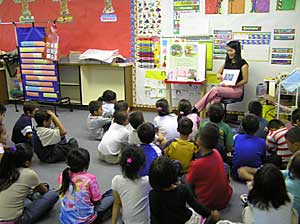
A study recently released by researchers at the University of California, Berkeley shows that children of Hispanic immigrants tend to be born healthy and are at the same level intellectually with other American children, but by the time they reach 2 years old they begin to fall behind in linguistic and cognitive skills.
For the most part, Hispanic mothers take care of their health while pregnant and give birth to healthy children, but these children begin falling behind their peers in mental development, and the gap widens as the children get older. The study suggests that the disparities may begin before the children even enter preschool, highlighting the importance of stimulating children with books, drills and games earlier in their lives.
“Our results show a very significant gap even at age 3,” said Bruce Fuller, one of the study’s authors and a professor of education at Berkeley. “If we don’t attack this disparity early on, these kids are headed quickly for a pretty dismal future in elementary school.”
Blacks and poor Whites were also lagging, which suggested that poverty may be a factor. However, Professor Fuller explained that the drop-off in cognitive scores of Hispanic children was significantly larger than for other groups, and could not be explained by economic factors alone.
The study’s authors suggested that one possible explanation is that a high percentage of Latin American, especially Mexican, immigrant mothers have less formal education than the average American mother. These same mothers tend to have more children than most middle-class American families; leading to less one-on-one attention from parents.
Data for the study was collected on 8,114 infants born in 2001 and followed through the first two years of their lives by the National Center for Education Statistics. Analysis showed Hispanic and white children performed at the same level from 9 to 15 months of age when tested on basic cognitive skills. But at 24 to 36 months, the Hispanic children fell behind in areas like word comprehension, more complex speech and working with their mothers on simple tasks.
Eugene Garcia, an education professor at Arizona State University, said this study confirmed similar findings by others that the children of Hispanic immigrants generally fall behind white students, sometimes as much as a grade level.
“It seems like what might be the most helpful with Latino kids is early intervention,” Dr. Garcia said.
According to Carmen Rodriguez, the director of the Columbia University Head Start in New York City, there is a waiting list of parents who want to take Early Head Start classes with their children – most of these parents are Hispanic.
Dr. Rodriguez said the study’s findings may simply show an increasing interest in early childhood education for middle-class Americans, instead of a deficiency in immigrant homes.
“Any low-income toddler is disadvantaged if they don’t get this kind of stimulation,” she said.

Recent Comments